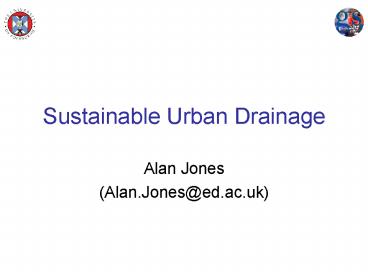Sustainable Urban Drainage - PowerPoint PPT Presentation
1 / 20
Title:
Sustainable Urban Drainage
Description:
Amenity value of surface water ... Rapid conveyance of water & pollutants. Local watercourse ... Drainage conveyance. Detention Basins. Retention Ponds ... – PowerPoint PPT presentation
Number of Views:387
Avg rating:3.0/5.0
Title: Sustainable Urban Drainage
1
Sustainable Urban Drainage
- Alan Jones
- (Alan.Jones_at_ed.ac.uk)
2
Sustainable Drainage
- A concept that focuses on the environment and
people. - Considers
- Quantity of runoff
- Quality of runoff
- Amenity value of surface water
- Existing urban drainage systems are
- Unsustainable in the long-term
- Damaging to the environment
3
Why are SUDS needed?
Hydrograph
Discharge
Time
- SUDS
- Attenuate flow
- Promote infiltration groundwater recharge
4
Why are SUDS needed?
- 11 of Scottish river length is classified as
polluted due to contamination from urban drainage
- SUDS aim to protect watercourses from
point/diffuse pollution by acting as sinks for
contaminants - Cost implications for maintaining long-term
performance of SUDS
5
Why are SUDS needed?
- Amenity
- A loaded term when used in relation to SUDS
environmental/community issues - Covers
- Aesthetic Ecological quality of the landscape
- Land-use
- Wildlife habitats
- Land-values
- Recreation opportunities
- Educational opportunities
- Water-resources
- Other factors
- Opportunity costs
- Perceptions of risk
- Construction impact
6
SUDS Triangle
7
Present Legal Status
- WFD Water Framework Directive (2000)
- Prevent deterioration in water status
- Restoration of surface waters to good ecological
and chemical status by 2015 - Reduction of pollution from priority substances
- Contributing to mitigating the effects of floods
and droughts - Preventing/limiting pollution input into
groundwater - CAR The Water Environment (Controlled
Activities) (Scotland) Regulations (2005) - Surface water-runoff in areas constructed, or
construction sites operated, after 1st April 2006
must now be drained by a Sustainable Urban
Drainage System - Exceptions Single dwellings or if the discharge
is to coastal water
8
Conventional Drainage
Precipitation Rainfall/Snow
Rapid conveyance of water pollutants
Local watercourse
9
SUDS Drainage The treatment train approach
- Connect SUDS together
- Individual function of local SUDS techniques
beneficial but design should be led by a
holistic vision approach - Combined integrated function mimics the
waterflows in the natural hydrological cycle - Surface Flow
- Infiltration
- Storage in water-bodies
- Interflow
- Evapotranspiration
10
Treatment Train
- Good Housekeeping best practice to eliminate, or
minimise, pollutants being generated and allowed
into the environment. - Source Controls methods of dealing with runoff
at source, e.g. permeable paving, filter strips,
or roadside filter trenches. - Site Controls local controls that deal with
generally smaller catchment areas, e.g. detention
basins. - Regional Controls larger components that might
typically deal with larger catchments and
upstream site controls, e.g. stormwater wetlands
and retention ponds. - (Heal, 2004)
11
A variety of techniques
Drainage conveyance
Kerb design
Roof drainage reuse
Detention Basins
Filter Drain
Swales
12
Retention Ponds
- Falkirk Stadium Retention Pond (Undeveloped
catchment)
13
Retention Ponds / Wetlands
- Lidl Distribution Centre, Livingston - Retention
Pond (Loading bay, Carpark runoff)
14
Tackling Contaminants
- The flood-reducing benefits of SUDS are
obvious... - Store water at various points in the catchment
and allow water to be re-used, infiltrated,
released slowly and/or evaporated. - These processes also allow the trapping of
potential contaminants (e.g. metals,
PAHs/Hydrocarbons) within the treatment train. - Contaminants are typically adsorbed
(physico-chemically bonded) to sediment particles
that are entrained in flow. - As water speed is slowed down using SUDS,
particles (and therefore contaminants) settle out.
15
Contaminant Sources Vehicles
- 15-fold increase in the number of car and taxi
miles covered over the last 50 years!
SUSTAINABLE (?)
Campbell et al. (2004)
16
Land-Use Contamination
(Beasley and Kneale, 2002)
17
Design - Site Constraints
- Physical site constraints can make construction
difficult or impossible, and maintenance
expensive if not addressed adequately. Factors to
consider include - topography - e.g. steep slopes
- soils and geology - e.g. erosivity, porosity,
depth to bedrock or instability - groundwater - e.g. geochemistry and water table
depth - space - limited open space, proximity to
underground services. (e.g. gas, power) - Social constraints include issues of health and
safety, aesthetics and impacts on recreational
facilities. Factors to consider include - odour problems
- visual impacts
- noise
- physical injury - resulting from unauthorised
access to structures - contamination - infection, poisoning or injury
caused by trapped pollutants or algal blooms - vermin - e.g. mosquitoes, rats.
18
Design Maintenance Issues
- Not only can a poorly maintained SUDS technique
function ineffectively, it can become a source of
pollution or flood hazard itself. - When designing a SUDS measure, the following
points should be considered - ease of maintenance and operation - the selected
treatment should be easy and safe to maintain and
operate - extent of maintenance - ensure the maintenance
requirements are within the operator's capability
- access to the treatment site - consider the ease
of site access, when reviewing the treatment's
maintenance requirements - frequency of maintenance - ensure that resources
are available to carry out maintenance at the
required frequency - debris and pollutant clearing - during clearing,
the treatment should not require direct human
contact with debris and trapped pollutants
(automated clearing options are preferred) - disposal - consider the disposal requirements of
any waste from the treatment process.
19
Case Study J4M8
- SUDS development (c. 2000)
- Previously agricultural land
- Now a distribution hub based mid-way between
Edinburgh and Glasgow
20
J4M8 Oblique Aerial Photograph































